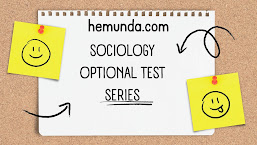HOME SCIENCE
PAPER-1
SECTION-B
Human Development and Family Studies.
Chapter-2
Development of children (0-5 years): Physical and Motor development, Intellectual development (Piaget’s stages of development) Development of emotion.
Sample Lecture from the Author Himself.
Past Years’ Questions from this chapter
Write in detail about Piaget’s stages of development.[ 2018, OAS Main Exam, 20 marks]
Detail on the sequence of the developmental stages of an infant up to pre-school years and also correlate the stages of psychosocial and intellectual development.[ 2017, OAS Main Exam, 60 marks]
Describe the stages of intellectual development from infancy and the role of stimulation.[2016, OAS Main Exam, 20 marks]
Describe the main educational principles that may serve as the basis for planning a Piagetian curriculum. Plan a preschool program framework using these principles.2011, OAS Main Exam, 60 marks]
Write in detail Piaget’s stages of cognitive development. Mention your views about how children learn supporting it with appropriate activities.[ 2006, OAS Main Exam, 20+40 marks]
Development of emotions from birth- 5 years.[ 2006, OAS Main Exam, 20 marks]
Write on the physical, motor, intellectual and emotional development of children aged 0-5 years.[ 2019, OAS Main Exam, 15 marks]
DEVELOPMENT OF CHILDREN (0-5 YEARS)
PHYSICAL DEVELOPMENT:-
Factors Affecting Physical Development
1) Inherited Traits & characteristics
2) Single or Multiple Births
3) Physical & Mental health of the mother during the pregnancy
4) Nutrition received by Embryo within the mother's womb.
5) Normal/Difficult delivery of the child
6) Conditions & care of the child during delivery
7) After birth care of the baby & mother
8) Nutrition received by the child after birth
9) Presence/Absence of Physical defect
10) Living conditions under which the child is brought up
11) Opportunities for Recreations, Self-Expression, Play & Exercise
12) Presence/Absence of Illness or Disease
13) Emotional & Social Adjustment of the child
14) Adequate or Inadequate Rest/Sleep
15) Proper/Improper Medical care
Hazards in Physical Development:-
1) Mortality – 1 st two weeks, 1 st year Illness, 2 nd year – Accident
2) Illness/Disease – Polio, whooping cough, Diphtheria, Tetanus, Measles, Mumps, TB, G.I &
Respiratory infections
3) Physical Handicaps- visual/auditory impairment, cerebral palsy, Orthopaedic/speech
Defect, cleft palate congenital anomalies.
4) Malnutrition – PEM
5) Disturbances in Homeostasis - Prolonged illness/stress, Dwarfism, High Blood Pressure,
Overweight/Underweight
6) Accidents – Due to too little supervision, motor incoordination, Hyperactivity, Lack of
emotional control, Rebellious attitude against adults, or overprotective attitude of adults.
MOTOR DEVELOPMENTS:-
This refers to the development of control over the body elements through co-ordinated
the activity of the Nerve Centres, the Nerves, and Muscles.
Significance of Motor Development:-
1) In case of lack of motor coordination, a child can not perform at par with other children of
his age
2) Motor Development Influences cognitive growth of the child only when the child crawls &
later walks, it can reach new things, they with toys & satisfy his curiosity
3) Good Motor Development helps in socialization. As the child explores his/her environment, he discovers the joy of talking to people, playing with friends.
4) Learning of motor skills enhances child’s maturity, Independence & feelings of security &
increase of self-confidence
FACTORS AFFECTING MOTOR DEVELOPMENT
1) Physical Health & Status
2) Sex Differences
3) Opportunity for practice
4) Motivation
Gross Motor Development (4-5 years):-
These movements involve a large area of the body that is used for Walking, Running, Swimming,
Climbing.
Fine Motor Development (After 5 years):-
It involves smaller muscle groups used effectively in Grasping, Throwing & Catching a Ball,
Wring, Using Tools.
Muscle coordination follows ‘Heart to Feet’ direction; Hand skills are learned faster from Leg
skills.
Principles of Motor Development:-
1) Motor Development depends on maturation
2) Skills are learned
3) Motor Development follows a predictable pattern - cephalocaudal[ pattern of changing spatial proportion over time],proximodistal[ functions of limbs to show finer details],Differentiation[mass to specific activities] & integration[gradual refinement of movements]
4) Individual Differences in developmental milestones.
INTELLECTUAL DEVELOPMENT
Intelligence refers to an overall capacity for learning- problem-solving.
It is a complex mental ability (potential for acquiring a skill) including the following:
Louis Leon Thurstone[ American Developmental Psychologist]’s Seven Primary Abilities:-
1) Verbal comprehension – Ability to Define & Understand words
2) Word Fluency – Ability to Think & Words Rapidly
3) Number – Ability to do Arithmetic Problems
4) Space Visualisation – Ability to visualize space & form, to remember form and manipulate it
mentally, Ability to Draw a Design from memory or to visualize Relationships
5) Memory- Ability to memorize or Recall or associate previously learned items
6) Perceptual Speed- Ability to grasp visual details; see small details accurately & quickly and see differences and similarities.
7) Reasoning- Ability to Find Rules, Principles, or concepts of understanding or solving problems
Factors Influencing Intelligence:-
1) Heredity – Mental Retardation & Giftedness run in families, Parental Intelligence
2) Environment – Better environment results in an increase in IQ scores
3) Gender – a) Girls are better in rate Memory Reasoning & Word Fluency
b) Boys are better in Spatial Intelligence & verbal comprehension
c) No difference in Numerical ability
4) Health – Good general health goes with high Intelligence
b) Malnutrition like PEM cause mental retardation
Jean Piaget[ Swiss developmental psychologist]’s stages of cognitive/ intellectual development.
Sensory Motor stage- [0-2 yrs]
Child Learns to control his body in space i.e Reflexes
Intelligence exists without symbols or language
The child learns by exploring, touching, tasking, seeing, hearing, smelling, etc.
For him/her, things that are not in sight, do not exist.
By the end of this stage, the child learns to control his/her body & understands that his/her body is different from space.
Pre-operational Stage[ 2- 7 years]
It is an ego-centered or self-centered stage. A child views everything in terms of himself/herself.
It is preparation for the period of logical thinking and operations, animism, and centration.
His/her learning requires expressions with real objects and things.
He/she thinks of things that are not present. Children enact roles & create imaginary situations.
Concrete operational Period-[ 7- 12 yrs]
His/her concepts become concrete & specific.
He/ she thinks deductively, from the concept of space & time, categorizes objects into larger, broader, etc.
Able to take the role of others which leads to a greater understanding of reality.
Seriation- can classify objects as length,size
Conservation- can deal with a number of different aspects simultaneously.
His/ her thoughts become increasingly logical & coherent.
He/ she can consider another person’s point of view.
Formal operational stage- [ 12 years onwards]
Can consider all possible ways of solving problems.
Able to give reasons on the basis of hypotheses and prepositions.
Thinking becomes more flexible and concrete
Can combine information from different sources.
Abstract, theoretical & philosophical matters are considered.
A balanced stage is arrived at by which contradictions are dealt with and resolved.
Piaget’s Major Processes of cognitive Development-
Schema
Assimilation
Cognitive equilibrium
Accommodation
Among these Assimilation & Accommodation are more important.
Assimilation- Incorporating new elements from the environment into an already existing mental framework.
Accommodation- It involves the modification of existing mental structure to fit a new perception of the environment.
These two processes are complementary to each other and keep occurring throughout the period of cognitive development.
Assimilation & Accommodation= Adaptation.
EMOTIONAL DEVELOPMENT.
Emotion is a complex state of feeling involving conscious experience, internal and overt physical responses, and power to motivate organisms to action.
Emotion is a subjective state, often accompanied by bodily and facial expressions having arousing and motivating properties.
Note- Extra topic
[Erik Erikson- Emotional and social development takes place in 8 stages]
Refer to the internet to know more about this topic.
Characteristics of Children’s Emotions
Emotions are intense
Emotions appear frequently.
Emotions are transitory
Emotional responses reflect individuality.
Emotions can be detected by behavior symptoms
Emotions change in strength.
The pattern of Emotional Development
Newborn- General excitement to strong stimulation with mass activity.
Lacks clear-cut responses and specific emotional states.
Two Weeks- Simple reactions suggesting delight and distress.
Delight-While sucking, Being rocked, patted, getting warmth by holding it.
Pleasant sounds- coos, gurgles.
Distress- Abruptly changing baby’s position, sudden loud noises, wearing wet diapers, etc.
Crying and mass activity.
Six Months- Fear, Disgust, Anger from Distress
Twelve Months- Elation and Affection from delight.
18 months- Jealousy & Affection to adults & children.
24 months- Delight differentiates into Joy.
5 years- Shame, Anxiety, Disappointment, envy[from distress]
Hope and parental Affection[ from Delight]
Through maturation and learning, finer emotions are acquired in subsequent years of childhood and adolescence.
Some Important Childhood Emotions
Fear-[2-6yrs]- Loud noise, Animals, Dark Room, Being Alone, pain, Strange Persons, Places, objects, fanciful, supernaturals, storms, etc.
Jealousy- Parents/Teachers favoritism, envied materials possessed by other children.
Affection- Mother, other relatives, teacher, friends
Joy- Smiling, laughing on physical well-being, success in any activity, doing better than other age-mates.
Curiosity- About unfamiliar objects, interest about their own body in preschoolers
Can be satisfied by explaining, manipulating, questioning & probing.
Anger- To show resentment.
To fulfill desires
Draw attention towards self
Crying, screaming, kicking, physical attack on persons/objects.






































0 Comments
please do not enter any spam link in the comment box.